 In every emergency situation, the first important step to perform is to survey the area, to check the area if there is any immediate danger present. When it comes to moving a seriously injured person, it is oftentimes best to not move the person, unless it is of absolute necessity, to reduce any chances for further injuries.
In every emergency situation, the first important step to perform is to survey the area, to check the area if there is any immediate danger present. When it comes to moving a seriously injured person, it is oftentimes best to not move the person, unless it is of absolute necessity, to reduce any chances for further injuries.
In an emergency, it may become necessary to transport an injured victim by one’s self. Some of the environments considered dangerous that require moving of the victim include near a fire or explosion or if falling debris is present. In addition, if the injury occurred out in the woods or other remote areas and need to be moved in order to find help, the victim must not be left alone and transported.
For short distances, an ankle pull or shoulder pull may be performed. To do an ankle pull, grasp the victim by either the two ankles or both pant cuffs. Ensure that the victim is moved using the rescuer’s legs and not the back. As much as possible, keep the back straight to avoid injury on self and drag the victim in as straight a line possible. However, this carry does not support the head or the neck. This method is the fastest way to transport a person over a smooth surface. This position can be done only if the rescuer cannot bend over or if there is immediate danger. To perform a shoulder pull, clutch the victim’s clothing underneath his or her shoulders. In order to pull the victim away, the rescuer must bend over and to support the victim’s head, keep an arm along each side of it. Pull the victim away, trying to keep the body as aligned as possible. This second form of transporting victim is preferred over ankle pull because there is support on the victim’s head. However, for victims with back injuries, this is not suited.
If the distance is considered short to medium, a blanket pull may be used. Lay out a blanket on the floor as close to the victim as possible. Carefully lift or roll the victim onto the blanket. Keep the head and neck aligned while moving the person to the blanket. From the corner of the blanket, the head should be placed about two feet from it. Grab the corners on the side of the victim’s head and pull them away. Keep back as straight as possible while moving the injured person.
For longer distances, a firefighter carry or pack strap carry may be done. To do a firefighter carry, stoop down and position one of the victim’s arms across the shoulder. The rescuer should wrap own arm around the victim’s legs and clutch the other arm of the victim. Carry the victim using the legs and bring the victim to safety. This is not advisable for victims with suspected spinal injuries. On the other hand, to do a pack strap carry, the rescuer must stoop down in front of the victim and place both of the victim’s arms over the rescuer’s shoulders. Cross the victim’s arms and grip the opposite wrist with both hands, such as holding the right wrist of the victim with the rescuer’s left hand and vice-versa. Pull the injured victim’s arms close to own chest and slightly squat. The rescuer should thrust own hip into the victim’s hip while slightly bending forward. Balance the person’s weight with hips while walking.
To carry a child or small adult over any length of distance, put one arm around the victim’s back and the second hand under the knees and lift the person into the arms. If possible, place the victim’s arm around the shoulders while walking. Walk the injured person to safety.
There are various ways that are possible to move the injured victims safely while minimizing risks for injuries. In first aid courses, the various ways of transporting victims are taught so that anyone can learn the proper way of moving victims when the situation calls for it.
